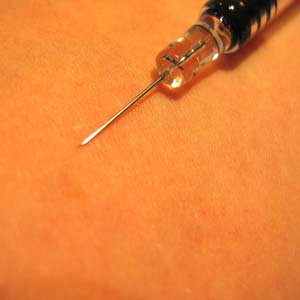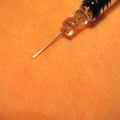Description of the test
The tuberculosis skin test tells your doctor whether or not you have or have ever had tuberculosis (TB). The bacterium Mycobacterium tuberculosis causes this condition. Tuberculosis is a severe illness of the lungs and respiratory system and may also affect other organs of the body.
To see if you have or have ever had the condition, a small amount of non-infectious proteins from the bacteria are placed under the skin of the arm. A reaction to these proteins indicates that you have been exposed to the bacteria that cause TB.
How often should the test be performed?
Your doctor will recommend when and how frequently this test is required.
You may have to do this test if you have been in contact with someone who has been diagnosed with an active TB infection or if you have just emigrated or are visiting from a country with a high incidence of TB. You may also have to do this test if you have a weakened immune system (e.g., due to an organ transplant, or HIV/AIDS) or if you are about to start medication that puts you at risk for a weakened immune system (e.g., chemotherapy) and an increased risk of tuberculosis infection.
Some employers require that you have this test be done before you begin working at certain jobs. In some jobs (e.g., in the health care field), you may be asked to have this test done every year.
Why is this test performed?
Doctors use this test to see if you have or have ever had TB or if you have been exposed to the bacteria that causes the condition. It is a severe illness that may lead to death if not treated with the proper medications.
Are there any risks and precautions?
Although this test is generally considered safe, some people may react severely to the antigens used in the test, leading to swelling and pain at the area of injection. Contact your doctor immediately if this occurs.
What happens during the test?
A trained health care professional disinfects the area on your inner forearm. Then a small amount of the TB proteins (called antigens or purified protein derivative [PPD]) is injected under the skin. A technician may circle the area to make it clear where the proteins were injected.
Most people feel nothing or only very slight discomfort during this test. It is normal to see a drop of blood at the injection site and this can be gently removed with a piece of gauze.
How should I prepare for this test?
Before having the TB skin test, be sure to mention whether you have had any symptoms that could be related to tuberculosis. Symptoms may include:
- a cough lasting more than two weeks
- poor appetite or loss of weight
- chills
- general fatigue and weakness
- chest pains
- fever
- coughing up of blood or mucous
- night sweats
If you have had TB, a positive TB skin test, an adverse reaction to a prior TB test, or a TB vaccination in the past, it is important to tell your doctor.
Speak to your doctor if you have any of these conditions because they can interfere with the accuracy of the TB test:
- HIV infection
- major viral infection, such as mumps or measles (note that this does not include the common cold)
- weak immune system
- extensive burns or eczema
- a measles vaccination within the last 6 weeks
Tell your doctor or prescriber about all prescription, over-the-counter (non-prescription), and herbal medications that you are taking. Also tell them about any medication allergies and medical conditions that you may have. Do not use an anesthetic cream before the test as these creams can cause mild swelling, which may be interpreted as a positive test.
Ask your doctor or pharmacist whether you need to stop taking any of your medications before the test.
What can I expect after the test?
After the test, do not cover the area with a bandage and do not scratch the test area, even if it is itchy (as this could interfere with the test). You must return to your doctor's office (or the clinic where the test was done) 2 or 3 days after the test to have the result checked by your health care professional.
It is important to speak to your doctor if you experience:
- fever
- swelling in the arm
- swelling in the underarm area (this indicates swollen lymph nodes)
Results
A health care professional will interpret the results of your TB test by looking at the area where the TB antigens were injected.
The result is positive if there is a firm bump larger than a certain size (the size depends on your medical history and risk factors). This means that, at some point in your life, you have been infected by the bacteria that cause TB.
The result is negative if there is either no bump or if the bump is smaller than a certain size (see above). The skin may be red or show no colour change.
Keep in mind that no test is 100% accurate, and as with any test, this test may produce false positive results (a positive result for someone who does not have the condition) or false negative results (a negative result for someone who really does have the condition).
In cases where a person has symptoms of tuberculosis, your doctor will consider the test result and determine the appropriate treatment. This test may be used in combination with other tests, such as chest X-rays (which can show whether a person has an active TB infection), to detect TB.
Antibiotics are the standard treatment for TB and they provide a safe, effective cure for this condition.
All material copyright MediResource Inc. 1996 – 2024. Terms and conditions of use. The contents herein are for informational purposes only. Always seek the advice of your physician or other qualified health provider with any questions you may have regarding a medical condition. Source: www.medbroadcast.com/procedure/getprocedure/Tuberculosis-Skin-Test




